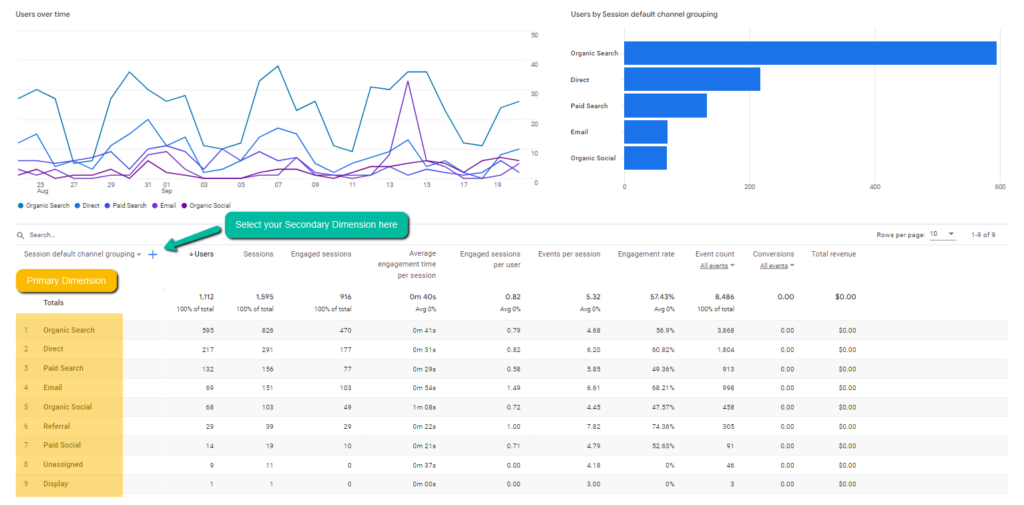Secondary Dimension in Google Analytics: Finest Practices and Tips
Secondary Dimension in Google Analytics: Finest Practices and Tips
Blog Article
Optimize Coverage Accuracy With Secondary Dimension in Google Analytics
Recognizing exactly how to maximize reporting precision with second measurements in Google Analytics can considerably improve the depth of understandings originated from information evaluation. By incorporating secondary measurements purposefully, online marketers can reveal hidden patterns and correlations that may not be promptly noticeable when assessing main metrics alone. This nuanced method makes it possible for a much more detailed understanding of customer habits and project efficiency, leading the way for even more targeted and effective decision-making. The usage of additional measurements holds the vital to opening a wide range of valuable information that can transform the efficiency of electronic advertising and marketing approaches.
Recognizing Additional Measurements in Google Analytics
Secondary dimensions enable individuals to segment and even more explore data beyond the main measurement chosen. While the key dimension might present the complete number of page views, adding an additional measurement such as 'source/medium' can supply insights right into where the web traffic originated from.
Furthermore, understanding second dimensions is important for developing extra customized reports tailored to particular service goals. By choosing the appropriate combination of secondary and main dimensions, analysts can reveal patterns, trends, and relationships that may otherwise continue to be surprise. This nuanced technique to information evaluation empowers businesses to make enlightened decisions based upon a comprehensive understanding of user behavior throughout numerous dimensions.

Just How to Apply Second Measurements
When leveraging secondary dimensions in Google Analytics, the practical application entails selecting details data specifications to additional fine-tune understandings beyond the key dimension's range. To use secondary measurements properly, begin by accessing the record or dataset where you desire to delve much deeper into the information. Keep in mind that second measurements help offer context and granularity to your primary measurement data, enabling you to draw out more meaningful and actionable insights from your Google Analytics reports.
Leveraging Second Dimensions for Insights
Utilizing additional dimensions in Google Analytics enables a much more thorough evaluation of information, supplying useful insights past the key dimension's extent. By leveraging secondary measurements, individuals can dive deeper into the performance metrics of their site or app, revealing hidden patterns and fads that might not be immediately apparent when just taking a look at primary measurements.
One secret benefit of using additional dimensions is the capacity to section and filter information more specifically. This can assist marketing experts and analysts much better recognize the actions of details customer sections, such as new site visitors versus returning site visitors, or web traffic originating from different geographic places.
Moreover, secondary dimensions allow individuals to compare and contrast numerous data factors within the exact same report, offering an extra holistic sight of performance (Secondary Dimension in Google Analytics). For instance, pairing the main measurement of touchdown web pages with second dimensions like demographics or tools can expose which pages are most effective in engaging users on different tools or from different market groups.
Essentially, leveraging secondary measurements in Google Analytics empowers individuals to remove richer insights from their information, resulting in even more informed decision-making and eventually, improved performance.
Finest Practices for Additional Measurements
When examining information in Google Analytics, including additional dimensions properly improves the depth of insights obtained from the primary metrics. Selecting relevant secondary measurements assists in providing context and a more clear understanding of the information being taken a look at.
Additionally, it is recommended to limit the variety of second measurements made use of in a solitary report to avoid frustrating the evaluation with too much details. Focusing on a couple of key secondary measurements at once can lead to even more concentrated and workable understandings. In addition, consider exploring with various combinations of primary and second dimensions to discover special patterns and patterns that may not appear when looking at the data in seclusion.
Advanced Evaluation Methods With Additional Dimensions
Exploring detailed data partnerships via the tactical application of second measurements can reveal nuanced insights that elevate the deepness of evaluation in Google Analytics. By incorporating secondary dimensions with main data collections, sophisticated analysis strategies can be utilized to remove useful information. One such strategy is friend evaluation, where additional dimensions enable the division of individuals right into teams sharing usual features. This technique enables a deeper understanding of individual habits patterns go to this site with time, aiding in the identification of fads and the assessment of marketing projects' efficiency.
Furthermore, additional measurements can enhance the evaluation of conversion courses by supplying extra context. Recognizing the different touchpoints an individual interacts with prior to transforming can be critical in maximizing the consumer trip - Secondary Dimension in Google Analytics. By making use of second measurements to look into specifics such as web traffic resources or gadgets used, online marketers can customize methods to target high-converting channels efficiently
Final Thought

To enhance data analysis and gain much deeper understandings into individual actions, recognizing secondary measurements in Google Analytics is important - Secondary Dimension in Google Analytics. Secondary measurements enable users to segment and better explore data beyond the primary measurement selected. While the primary measurement might display the complete number of page views, including a secondary measurement such as 'source/medium' can give insights right into where the view web traffic originated from.When leveraging second dimensions in Google Analytics, the practical application more information entails choosing particular data specifications to additional fine-tune insights beyond the primary dimension's scope. Remember that second dimensions help supply context and granularity to your primary measurement data, allowing you to draw out even more workable and meaningful understandings from your Google Analytics records
Report this page